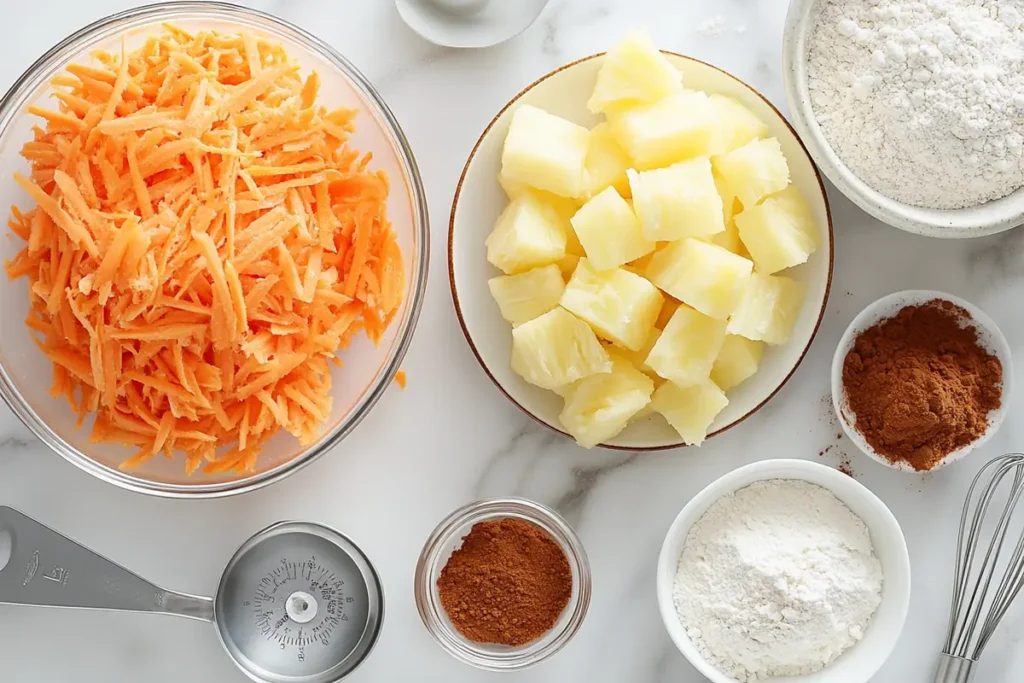Introduction
Carrot cake is a timeless classic, loved for its moist feel, warm spices, and rich flavors. But have you ever wondered why put pineapple in carrot cake? Pineapple is more than just a fruity addition; it transforms the cake into a moist, flavorful masterpiece that’s hard to resist. In this article, we’ll not only explore the history, benefits, and science behind adding pineapple to carrot cake, but we’ll also share a tried-and-true recipe. Additionally, we’ll answer common questions about this delightful combination. So, without further ado, let’s dive in!
The Origins of Pineapple in Carrot Cake
The Evolution of Carrot Cake
Carrot cake has a fascinating history. Its roots trace back to medieval Europe when sweeteners were scarce, and carrots, being naturally sweet, were used as a substitute. Over time, this humble dessert evolved, gaining popularity for its unique blend of sweet and spiced flavors.
By the mid-20th century, carrot cake had firmly established itself as a staple in American households. As a result, bakers began experimenting with different ingredients in an effort to enhance its feel and flavor. Eventually, this experimentation paved the way for pineapple to enter the mix, ultimately creating a tropical twist on a classic dessert.
The Introduction of Pineapple
Adding pineapple to carrot cake became a trend in the mid-1900s, particularly in the United States. Tropical fruits like pineapple were becoming more accessible, and bakers loved how the fruit’s natural sweetness and moist complemented the dense feel of carrot cake. This addition wasn’t just about taste; it also made the cake more visually appealing with its bright, golden flecks.
Over time, pineapple quickly gained a reputation for elevating carrot cake from a simple dessert to a show-stopping treat. Not only did its inclusion add depth and balance, but it also introduced a hint of tropical flair that delighted taste buds.
Benefits of Adding Pineapple to Carrot Cake
Enhanced moist and feel
One of the main reasons bakers choose to add pineapple to carrot cake is because of its ability to lock in moisture. In fact, pineapple’s high water content not only softens the cake but also ensures that every bite is tender and satisfying. As a result, this tropical fruit has become a go-to ingredient for achieving the perfect texture. In addition, its fibrous feel blends seamlessly with grated carrots, creating a cake that feels rich without being overly dense.
Adding pineapple also helps balance the cake’s structure. While carrots add bulk, pineapple introduces just the right amount of acidity and moist , preventing the cake from becoming dry or crumbly. This combination results in a dessert that stays fresh longer, making it ideal for gatherings or celebrations.
A Natural Sweetener with Depth
Pineapple’s natural sweetness makes better the flavor profile of carrot cake. Unlike sugar, pineapple brings a subtle tanginess that complements the warmth of spices like cinnamon and nutmeg. This contrast elevates the cake, creating a multi-dimensional flavor that’s both sweet and slightly tart.
For those looking to reduce added sugars, pineapple can serve as a natural sweetener. Using crushed pineapple instead of additional sugar allows you to maintain the cake’s sweetness while keeping it healthier.
How Pineapple evens out Flavors and Ingredients
The Role of Acidity in Baking
Acidity plays a crucial role in baking, and pineapple is an excellent source of natural acid. The tartness of pineapple helps to brighten the overall flavor of carrot cake, cutting through the richness of cream cheese frosting or butter-based ingredients. This balance ensures that the cake doesn’t feel overly heavy or one-dimensional.
Moreover, the acid in pineapple interacts with leavening agents like baking soda or baking powder. This reaction helps the cake rise evenly, giving it a light and airy feel. For bakers who prioritize a perfect crumb, pineapple is a game-changer.
A Harmony of Sweet and Spiced Flavors
Carrot cake is widely known for its warm, spiced flavors, which come from ingredients like cinnamon, nutmeg, and ginger. Moreover, pineapple complements these spices beautifully, as it adds a refreshing fruitiness that enhances every bite. In this way, the tropical twist perfectly balances the earthy spices. The result is a cake that feels both cozy and vibrant, making it a hit for any occasion.
Adding pineapple doesn’t just enhance flavor; it also adds a pop of color. The bright yellow flecks of pineapple stand out against the orange hues of the carrots, making the cake as visually appealing as it is delicious.
Step-by-Step Recipe for Pineapple Carrot Cake
Ingredients for Pineapple Carrot Cake
To create a moist and flavorful pineapple carrot cake, you’ll need the following:
For the Cake:
- 2 cups (250g) all-purpose flour
- 1 1/2 teaspoons baking soda
- 1 teaspoon baking powder
- 1/2 teaspoon salt
- 1 teaspoon ground cinnamon
- 1/2 teaspoon ground nutmeg
- 1/2 teaspoon ground ginger
- 3/4 cup (150g) granulated sugar
- 3/4 cup (150g) brown sugar
- 3 large eggs
- 2/3 cup (160ml) vegetable oil
- 2 teaspoons vanilla extract
- 2 cups (200g) grated carrots
- 1 cup (240g) crushed pineapple, drained
- 1/2 cup (50g) chopped walnuts or pecans (optional)
For the Cream Cheese Frosting:
- 8 ounces (225g) cream cheese, softened
- 1/2 cup (115g) unsalted butter, softened
- 3 cups (360g) powdered sugar
- 1 teaspoon vanilla extract
- 1 tablespoon pineapple juice (optional for added flavor)
Instructions: How to Make Pineapple Carrot Cake
- Preheat the Oven
Set your oven to 350°F (175°C) and grease two 9-inch round cake pans. Line the pans with parchment paper for easy removal. - Mix the Dry Ingredients
In a large bowl, whisk together the flour, baking soda, baking powder, salt, cinnamon, nutmeg, and ginger. Set aside. - Prepare the Wet Ingredients
In another bowl, combine the granulated sugar, brown sugar, eggs, vegetable oil, and vanilla extract. Whisk until the mixture is smooth and well-blended. - Combine the Wet and Dry Mixtures
Gradually add the dry ingredients to the wet mixture, stirring gently until just combined. Avoid overmixing to ensure a tender cake. - Incorporate Carrots and Pineapple
Fold in the grated carrots and crushed pineapple. If desired, add chopped walnuts or pecans for extra feel and flavor. - Bake the Cake
Divide the batter evenly between the prepared cake pans. Bake for 30–35 minutes or until a toothpick inserted in the center comes out clean. Allow the cakes to cool completely before frosting. - Prepare the Cream Cheese Frosting
In a mixing bowl, beat the cream cheese and butter until creamy. Gradually add the powdered sugar and continue beating until smooth. Mix in the vanilla extract and pineapple juice, if using. - Assemble the Cake
First, spread a generous layer of frosting between the two cake layers. Then, cover the top and sides with the remaining frosting to ensure an even finish. Finally, garnish with extra walnuts or pineapple chunks, if desired, for a decorative and flavorful touch.

Nutritional Content and Benefits of Pineapple Carrot Cake
Nutritional Content (Per 100g)
| Nutrient | Amount |
|---|---|
| Calories | 340 kcal |
| Total Fat | 15g |
| Saturated Fat | 5g |
| Cholesterol | 40mg |
| Sodium | 220mg |
| Total Carbohydrates | 45g |
| Dietary Fiber | 2g |
| Sugars | 30g |
| Protein | 4g |
| Vitamin A | 120% DV |
| Vitamin C | 6% DV |
Health Benefits of Pineapple Carrot Cake
Including pineapple in carrot cake isn’t just about flavor—it’s also a nutritional win. In addition to its sweetness, pineapple provides vitamin C, which boosts immunity and aids collagen production. Moreover, carrots are rich in beta-carotene, a precursor to vitamin A that supports vision and skin health. By combining these ingredients with nuts, you also get a dose of healthy fats, ultimately making this cake a delightful and nourishing treat.

FOR MORE DELICIOUS RECIPES:
What is Inside a Tortellini? Exploring the Fillings and Flavors
Common Variations and Customizations for Pineapple Carrot Cake
Adding Tropical Flavors
One of the best reasons to include pineapple in carrot cake is its ability to introduce a tropical twist. While the classic combination of carrots and spices is undeniably comforting, adding pineapple takes it to a whole new level of flavor. You can use coconut flakes or even mango chunks alongside pineapple to make your cake truly tropical.
Additionally, substituting part of the flour with almond flour can enhance the nuttiness while complementing the fruitiness of the pineapple.
Alternative Sweeteners and Mix-Ins
For those who prefer a less sweet version, consider using honey or maple syrup instead of granulated sugar. These natural sweeteners pair beautifully with the pineapple’s tangy sweetness. Another fun mix-in option is golden raisins, which add bursts of flavor and a chewy feel. Alternatively, shredded zucchini can be added for extra moist without altering the flavor profile.
Tips for Perfecting Pineapple Carrot Cake
Preventing a Soggy Cake
A common concern when adding pineapple to carrot cake is the potential for sogginess. To avoid this issue, make sure to drain the crushed pineapple thoroughly before mixing it into the batter. You can press the pineapple gently using a sieve or cheesecloth to remove excess juice.
Additionally, balancing the wet ingredients with the correct ratio of dry ingredients is essential. If the batter feels too runny, adding a tablespoon of flour at a time can help achieve the perfect consistency.
Frosting Tips for a Professional Look
A smooth and evenly frosted cake is not only visually appealing but also easy to achieve with the right tools and techniques. To begin with, use a bench scraper to spread the cream cheese frosting evenly over the sides of the cake. Additionally, for a decorative touch, consider piping frosting rosettes on top or sprinkling toasted coconut or chopped nuts as a garnish.
For an extra layer of flavor, mix a teaspoon of pineapple zest into the frosting. This subtle addition ties the cake’s flavors together beautifully.
The History of Pineapple in Carrot Cake
Origins of the Combination
The history of carrot cake is rich and fascinating, with origins tracing back to the medieval period when sugar was a rare and expensive commodity. During this time, carrots were used as a natural sweetener in desserts. This practical approach to baking eventually gave birth to the modern carrot cake, a beloved dessert known for its moist feel and spiced flavor.
The addition of pineapple, however, is a more recent innovation, thought to have emerged in the mid-20th century. Canned pineapple became widely available after World War II, making it a convenient ingredient for home bakers looking to enhance their recipes. Its sweetness, combined with its ability to retain moist, quickly made pineapple a popular addition to carrot cake, especially in American households.
Pineapple’s Role in Evolving Recipes
As carrot cake evolved, bakers gradually began experimenting with ingredients that could potentially elevate its flavor and texture. Notably, pineapple proved to be a game-changer. Thanks to its juicy, tangy-sweet profile, it added a refreshing dimension to the cake, while perfectly balancing the warm spices and earthy notes of the carrots. Moreover, the natural enzymes in pineapple contributed to a tender crumb, making each bite soft and luscious.
This combination gained even more popularity as tropical-inspired desserts became trendy in the United States during the 1950s and 1960s. Pineapple carrot cake started appearing in cookbooks and on restaurant menus, cementing its status as a modern classic. Today, it’s celebrated for its perfect harmony of flavors, appealing to both traditionalists and adventurous bakers.
A Global Favorite
While pineapple carrot cake is particularly popular in North America, its appeal has crossed borders. From bakeries in Europe to home kitchens in Asia, this dessert has become a favorite worldwide. Pineapple’s tropical essence pairs beautifully with the versatile carrot base, making it adaptable to various regional preferences and culinary styles.
Cultural and Culinary Significance
The inclusion of pineapple in carrot cake is more than just a flavor enhancement—it represents the blending of traditions and the creativity of modern baking. By thoughtfully incorporating an ingredient that wasn’t historically part of the recipe, bakers have remarkably expanded what this classic dessert can be. Indeed, it’s a testament to the ever-evolving nature of food, where even a simple addition can effortlessly transform a dish into something extraordinary.
Whether you’re baking for a family gathering or experimenting with new recipes, understanding the origins of pineapple in carrot cake adds a deeper appreciation for this timeless dessert.

How to Customize Carrot Cake with Pineapple
Incorporating Pineapple into Different Versions of Carrot Cake
Adding pineapple to carrot cake opens up a world of customization possibilities, allowing bakers to tailor this dessert to their tastes. Whether you prefer traditional recipes or modern twists, pineapple can enhance both flavor and feel in various ways.
Pineapple Chunks vs. Crushed Pineapple
When choosing how to incorporate pineapple, consider the feel you want to achieve. Crushed pineapple integrates seamlessly into the batter, ensuring every bite is moist and flavorful. On the other hand, pineapple chunks provide bursts of tropical sweetness and a slightly firmer bite, adding a delightful contrast to the cake’s tender crumb.
For a layered carrot cake, crushed pineapple works best as it spreads evenly, complementing the creamy frosting. Pineapple chunks, however, can be ideal for single-layer or loaf-style cakes where a rustic feel is desired.
Pineapple-Infused Frosting
For an extra tropical flair, incorporate pineapple into your frosting. A small amount of pineapple juice or finely blended crushed pineapple can be mixed into cream cheese frosting, lending a subtle tangy sweetness. This not only complements the cake but also creates a visually appealing finish with hints of yellow.
Combining with Other Ingredients
Pineapple pairs beautifully with other complementary ingredients. Shredded coconut, for instance, makes better the tropical theme, while chopped nuts like pecans or walnuts add crunch. For a spicier kick, consider adding a dash of ginger or cardamom to balance the pineapple’s sweetness.
Healthier Alternatives and Dietary Adjustments
If you’re aiming for a lighter version, you can use unsweetened pineapple to reduce added sugars. Additionally, substituting some of the oil in the recipe with pineapple juice can lower the calorie content without compromising moist.
For individuals with dietary restrictions, carrot cake with pineapple is incredibly adaptable. For instance, you can use gluten-free flour blends or even plant-based substitutes like flaxseed meal for an egg-free option. Additionally, the pineapple ensures the cake remains moist, despite any ingredient swaps.
Creative Presentation Ideas
Indeed, the way you present your carrot cake can truly elevate it from delicious to unforgettable. For example, for a special occasion, garnish the cake with candied pineapple slices or toasted coconut flakes. On the other hand, if you’re serving cupcakes, top each one with a small piece of pineapple as well as a sprinkle of cinnamon to create a charming finish.
Layered carrot cakes truly look stunning because of their alternating layers of cake and pineapple-infused frosting. Additionally, they can be decorated with edible flowers or fresh mint leaves to add a pop of color, making them both visually appealing and delicious.
Embracing Your Creativity
Customizing carrot cake with pineapple is primarily about experimentation. For instance, by mixing and matching flavors, textures, and presentation styles, you can easily create a dessert that’s not only unique but also incredibly satisfying. Whether you stick to tradition or venture into uncharted flavor combinations, the versatility of pineapple ensures your carrot cake will always be a crowd-pleaser.
FOR MORE DELICIOUS RECIPES:
Why Do Walnuts Go Black in Carrot Cake? A Comprehensive Guide

